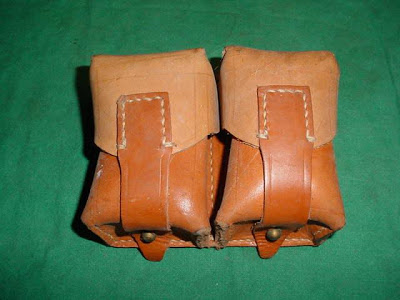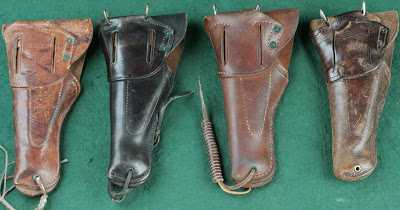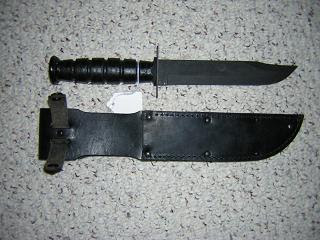
This just in from Doctor Enigma:
In this day of MOLLE, Cordura, Gortex, and Nylon belts, vests, holsters and sheaths, one might not stop to think about how to properly waterproof leather accouterments prior to going to the field. Being there are still many people who use leather knife sheaths, holsters, and pouches of varying types on their gear. This method might be of some use.

Step 1: Clean the leather of all dirt, mud, etc, and let dry thoroughly. Set it by your home heater vent or in the sun for a day or two.
Step 2: While the leather is drying, go buy a jar of SNO-SEAL for about $5. If it isn't in your area, here's the on-line source: http://www.atsko.com/products/waterproofing/sno-seal.html
Step 3: Get a pice of heavy duty tin foil large enough for the item to sit on and have about 4 inches clearance from the edge all the way around. Double thick if you only have regular strength foil.
Step 4: Turn your oven on to about 175 degrees and let it pre-heat. This heat is enough to warm the leather, melt the SNO SEAL and expedite the absorption of the SNO SEAL by the leather.
Step 5: While your oven is heating, take a paper towel or soft cloth that doesn't shed lint and smear the SNO SEAL inside and out liberally so there's a thick coat on it, especially over any stitching, on one side.

Step 6: Put the item on the tin foil and put the whole thing in the oven on the middle rack.
Step 7: Check on it every 5 minutes or so while the SNO SEAL melts and is absorbed into the leather. If you notice any signs that the temperature is too hot, take the item out of the oven and turn down the oven in 25 degree increments until it stops. It shouldn't be a problem, but just in case....
Step 8: When the leather has absorbed all the SNO SEAL, take it out and while still warm/hot, turn it over and coat the other side of the item with the SNO SEAL and repeat the process of baking it into the item. Make sure you coat any areas with stitching very thickly.
Step 9: Once the second side is done, take the item out of the oven and let cool. When it's cool to the touch, check for any areas that didn't absorb the SNO SEAL well. Let the item stand for a couple days, and then repeat until the leather will not absorb SNO SEAL anymore. You'll know this because when it melts in the oven, the leather will just have the liquified SNO SEAL pooling on it.
Step 10: Take a soft cloth and buff the excess off.
Once you've got a SNO SEAL impregnated leather accouterment, you'll find that it withstands weather, heat, cold, rain, and anything else (like mud) very, very well. You might have to recoat it every couple years, but that's about it.
6 comments:
My own personal preference is "Obenaufs":
http://www.obenaufs.com/product_info.php?cPath=33&products_id=11&osCsid=91c1c0ff58fcd5daea4e80b51bb6443e
Bob
III
There is another product called Huberds Shoe Grease. Comes in a small blue and white can. Use in the same way. I have used it on leather boots for years andit works extremely well.
I liked the article but I think the 175 degrees F might be a little high for some stiching, nylon in particular. I've been using Sno-Seal for about 40 years now, truly great stuff. I'd say that 125 - 135 degrees F should prove sufficient if you can get your oven to run that low. Otherwise, a good 1500 watt hair dryer or a commercial heat gun set to low should do the trick.
In dealing with old leather, or leather that is worked hard daily, you can't have it both ways.
What's been talked about, is a single way to call your old leather, good.
Not possible.
You have to get the dirt out of old leather, first. Neatsfoot oil does this, it brings the dirt to the surface of the leather.
Next, is to get the dirt off of the surface. Saddle soap is best for this. The best saddle soap, is found in the form of a bar, like a bar of soap. It's around, you might have to shop some.
This is old school stuff, the idea of using one product to get dirt up out of leather and another to get it off. It worked for many years, this way, for mounted troops. This, during times when money was scarce and horses were expensive as Armies dealt with the requirements of mounted troops and their leather goods.
The idea of driving wax (Snow Seal, as in the original post) into vintage leather via heat, is something that I cannot stomach. Sorry about that.
When the leather got tanned, the origins of its eventual destruction got built in. McClellan saddles and all, all good leather is going downhill from the time it leaves the shop.
There is no reason to accelerate the destruction of a leather product, by trying to bake Snow Seal into it. Old ways...neatsfoot and bar-type leather soap, will make those items last much longer than will baking them with Snow Seal.
PF
I stay indoors when it rains, LOL!
Thanks this is a great tip because I've always used mink oil which seems to work fine. But knowing you guys know about mink oil and are not using it and using something that sound like a pain to apply. Its like anything else, you get out of it what you put into it. I'll give it a try.
For the detractors to this method (not the guys who use different products), I only offer the following quote:
"This method might be of some use."
Any quotes on this being the "end all - be all"? Nope.
Are there other methods? Sure.
Are there better methods? Probably.
Is anyone else offering help MBV get information to those who might not have the knowledge to prepare their older gear? Only a very few....some seem content to sit back and bitch in the comments section.
Post a Comment